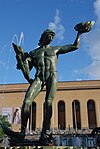Torstenson Palace
| Torstenson Palace | |
|---|---|
Torstensonska Palatset | |
Riksantikvarieämbetet . |
57°42′21″N 11°57′35″E / 57.70583°N 11.95972°E
The Torstenson Palace is a building on Södra Hamngatan in
The building was originally constructed in the years 1648–1650 for Count
The palace is Gothenburg's oldest residential building, and has been recognised as a byggnadsminne (listed building) since 25 January 1935.[7][8] The building's most famous role in recent years was as the venue for the 2001 meeting of the European Council.[9]
History
General Count
Torstensson died on 7 April 1651 in Stockholm, and six years later King
On 9 May 1700 the seat of the
The Torstenson Palace remained the seat of the county administration of Gothenburg and Bohus County throughout these upheavals and over the following two centuries. After Gothenburg and Bohus was merged with Skaraborg County and Älvsborg County to form Västra Götaland County in 1998, the Palace became the seat of the county administration of the new, larger unit.[6]
The Torstenson Palace has been remodelled and rebuilt several times in its history, most notably in 1875, when the house's area increased from just under 700 square meters to 1800 square meters.
The Torstenson Palace shares a large courtyard space with the properties Södra Hamnatan 3 and Stora Badhusgatan 2.,[15] and has given its name to the Residence Bridge, (Swedish: Residensbron) which was completed in 1963 and crosses the harbour canal at Stora Bommen.[16]
References
- ^ Residenset, map from Lantmäteriet.
- ^ Residenset Archived 2014-07-14 at the Wayback Machine, Länsstyrelsen i Västra Götaland.
- ISBN 91-86050-67-2s. 35
- ^ a b Bæckström (1923), p. 80.
- ISBN 91-85786-13-6., pp. 26-27.
- ^ a b c Göteborg under 300 år, Carl Lagerberg & Otto Thulin, Medéns Bokhandels AB, Wald. Zachrissons Boktryckeri, Göteborg 1923 p. 31.
- Riksantikvarieämbetet.
- ^ Kulturhistoriskt värdefull bebyggelse i Göteborg : inventering utförd vid Byggnadsminneskontoret, Göteborgs historiska museum 1970 (?), p. 15.
- ^ "Presidency conclusions" (PDF). consilium.europa.eu. Retrieved 21 September 2023.
- ^ Clemensson & Kjellberg (1933), pp.25–26
- ^ Kronologiska anteckningar om viktigare händelser i Göteborg 1619–1982, A. Rundqvist/R. Scander/A. Bothén 1982 pp.6–7
- ^ a b Nyström (1984), p.35.
- ^ Nyström (1984), p.32
- ^ Lönnroth (2003), p. 383.
- ISBN 91-89088-12-3p. 382.
- ^ Gothenburg Harbor Board – annual report 1963, p. 11
Sources
- 100 utmärkta hus i Göteborg. [Arkitekten och staden] ; [3]. Göteborg: Manne Ekman & Margareta Rydbo, Göteborgs stadsmuseum i samarbete med Göteborgs-posten. 2001. pp. 46–47. ISBN 91-85488-54-2.
- Residenset, map from Lantmäteriet. Retrieved 8 July 2014.
- "Länsresidenset Göteborg", Bebyggelseregistret, Riksantikvarieämbetet. Läst 8 July 2014.
- Femte roten, tomt 52, Kvarteret Residenset. Göteborgs tomter. Läst 8 juli 2014.
- "Landsstathuset", Bebyggelseregistret, Riksantikvarieämbetet. Retrieved 8 July 2014.
- Residenset, ed. Ingrid Holmberg, published by Kulturmiljöenheten vid Länsstyrelsen i Göteborgs och Bohus län 1992
- Residenset i Göteborg: 350 år i rikets tjänst, ed. Anders Franck, published by ISBN 91-85488-55-0, ISSN 1404-9546
- G. Clemensson & Sven T. Kjellberg (1933). Monumenta Gothoburgensia.
- Per Nyström (1984). Länsresidenset i Göteborg. Göteborgs historiska mus. ISBN 91-85786-13-6.
- Studier i Göteborgs byggnadshistoria före 1814: Ett bidrag till svensk stadsbyggnadshistoria, [utvidgad upplaga], Serie: Svensk byggnadskultur, 99-0887545-0 ; 2, fil lic Arvid Bæckström, Nordiska museet, Stockholm 1923
- GHT, 24 April 1948, "Residenset jubilerar," av Olof Nordenskjöld.
Further reading
- Fredberg, Carl Rudolf A:son (1921–1922). Det gamla Göteborg: lokalhistoriska skildringar, personalia och kulturdrag. Volume 2. Göteborg. pp. 73–98.
{{cite book}}: CS1 maint: location missing publisher (link) - Nilsson, Staffan (2000). Svenska residens (1. uppl. ed.). Stockholm: Svensk byggtjänst. pp. 132, –141. ISBN 91-7332-927-4.

